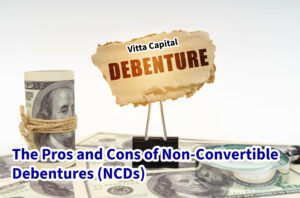
The Pros and Cons of Non-Convertible Debentures (NCDs)
Non-Convertible Debentures (NCDs) are fixed-income instruments offering a higher return than traditional fixed deposits but come with their own set of advantages and risks. Let’s explore their features, benefits, and potential pitfalls to help you make informed investment decisions.
1. What Are Non-Convertible Debentures (NCDs)?
- Definition: Debt instruments issued by companies to raise capital, offering periodic interest payments.
- Non-Convertible: Unlike convertible debentures, NCDs cannot be converted into equity shares of the issuing company.
Types of NCDs:
- Secured NCDs: Backed by the company’s assets, offering lower risk.
- Unsecured NCDs: No backing of assets, hence higher risk but higher returns.
2. Key Features of NCDs
- Fixed Tenure: Typically ranges from 1 to 10 years.
- Higher Returns: Offers better interest rates compared to fixed deposits.
- Listed on Stock Exchanges: Can be traded, providing liquidity.
- Credit Ratings: Issued by agencies like CRISIL and ICRA to indicate default risk.
Example:
An NCD offering 9% annual interest with a tenure of 5 years might appeal to investors seeking higher returns than a bank FD offering 7%.
3. Benefits of Investing in NCDs
A. Attractive Returns:
- Interest rates are generally higher than bank deposits or government bonds.
B. Regular Income:
- Offers periodic payouts such as monthly, quarterly, or annual interest.
C. Diversification:
- Helps in diversifying a portfolio with fixed-income instruments.
D. Liquidity:
- Listed NCDs can be sold on stock exchanges before maturity.
E. Transparency:
- Credit ratings help investors assess the safety of their investment.
4. Risks Associated with NCDs
A. Credit Risk:
- If the issuer defaults, investors may lose their principal and interest.
Example: Companies with lower credit ratings carry higher default risks.
B. Liquidity Risk:
- Selling NCDs in the secondary market may be difficult due to low trading volumes.
C. Interest Rate Risk:
- If market rates increase, the value of existing NCDs decreases.
D. No Capital Appreciation:
- Unlike equities, NCDs don’t offer any potential for capital gains.
5. Comparing NCDs with Fixed Deposits (FDs)
| Factor | NCDs | FDs |
|---|---|---|
| Returns | Higher interest rates | Moderate interest rates |
| Risk | Higher (credit risk) | Lower (insured up to ₹5L) |
| Liquidity | Traded on stock exchanges | Locked-in until maturity |
| Tenure Flexibility | Customizable options | Fixed tenures offered |
6. Factors to Consider Before Investing
A. Credit Rating:
- Opt for NCDs with high ratings (AAA or AA) for lower risk.
B. Issuer’s Financial Health:
- Analyze the company’s balance sheet and repayment history.
C. Interest Payment Options:
- Choose between cumulative and non-cumulative payouts based on cash flow needs.
D. Tax Implications:
- Interest earned is taxable as per the investor’s income slab.
E. Investment Horizon:
- Ensure the NCD’s tenure aligns with your financial goals.
7. Real-Life Example: Choosing NCDs Wisely
Scenario:
- Ramesh wants to invest ₹10 lakhs for 5 years.
- Options: A AAA-rated NCD offering 8% interest or a lower-rated one offering 11%.
Decision Process:
- Ramesh chooses the AAA-rated NCD for safety despite lower returns, aligning with his conservative risk profile.
8. Tax Implications of NCDs
A. Interest Income:
- Fully taxable as per the investor’s income tax slab.
B. Capital Gains:
- Gains from selling NCDs in the secondary market are subject to short-term or long-term capital gains tax.
9. Who Should Invest in NCDs?
- Risk-Tolerant Investors: Willing to accept credit risk for higher returns.
- Income-Oriented Investors: Looking for steady, periodic payouts.
- Diversified Portfolio Seekers: Want to balance equities with fixed-income instruments.
10. Conclusion
NCDs are a compelling option for investors seeking higher returns and regular income, but they demand careful evaluation of credit ratings, issuer reputation, and associated risks. A balanced approach can help reap the benefits while minimizing potential downsides.